Bullionz: A Unique Platform Merging Real Gold Ownership and Cryptocurrency Exchange

The post Bullionz: A Unique Platform Merging Real Gold Ownership and Cryptocurrency Exchange appeared first on Coinpedia Fintech News
Online platforms have made gold trading more accessible, but many stop at offering only a virtual representation of gold’s value—without any true ownership. Bullionz changes this by introducing a token that is gold-backed and gives users a direct claim on physical gold.
Each BTXG token is tied to one gram of real gold, bridging the gap between tangible assets and digital ease. With Bullionz, investors gain the stability of physical gold combined with the agility of a cryptocurrency exchange. This unique platform offers everything from token redemption for physical gold and secure storage options to real-time market insights.
Bullionz: Uniting Gold and Crypto in One Platform
Bullionz seamlessly brings together traditional finance (TradFi) and decentralized finance (DeFi), allowing users to manage both physical gold and cryptocurrency on a single platform. Central to this system is BTXG, which is directly backed by one gram of real gold. BTXG avoids the volatility that often affects digital currencies, this offers users a stable, reliable asset within a flexible, digital setting.
Beyond BTXG, Bullionz enhances the gold-owning experience by offering a Gold Shop where users can purchase physical gold in various forms, from coins to bars. This feature allows users to build or expand their gold holdings directly through Bullionz, giving them more control and convenience.
BTXG: Beyond a Standard Token
Bullionz’s BTXG redefines what it means to own gold in the digital age, giving users practical options for managing their assets flexibly and securely:
- Secure Storage: For those who value ownership but prefer off-site security, Bullionz provides high-standard vaults to store gold holdings. This option offers the best of both worlds: the reassurance of a tangible asset combined with the ease of managed storage, freeing users from the burdens of physical handling.
- Doorstep Delivery: Bullionz has streamlined the process with international shipping solutions. Users can have their gold delivered directly, making physical gold ownership accessible and convenient.
- Community-Based Earning: BTXG holders can benefit from a community rewards system. Through pooled returns, Bullionz redistributes part of the platform’s gains to BTXG holders, creating an additional financial advantage that complements traditional gold investment.
A User-Friendly Platform with Real-Time Insights
Bullionz allows users to securely manage all crypto holdings through dedicated crypto wallets, while fiat and gold are organized in separate gold wallets. This makes it easy to keep track of each type of asset. The platform also allows seamless conversions between wallets, providing flexibility for users who want to transition between fiat, gold, and crypto investments.
The platform’s real-time analytics offer users clear, visual data on asset performance. With easy-to-read charts and graphs, Bullionz keeps users updated on the latest trends across crypto, forex, and gold markets, giving them the insights they need to make informed trading decisions.
Every transaction is documented, offering transparent histories to ensure users always have a clear record of their activity. Beyond the basics, Bullionz empowers users with comprehensive market updates and news, available directly from the dashboard.
This feature allows users to stay informed on market shifts and emerging opportunities, enhancing decision-making. Combining gold’s stability with crypto’s liquidity, Bullionz offers a powerful portfolio management tool, where users can balance high-yield assets with more stable holdings, hedging against economic volatility with ease.
Bottom Line
Bullionz offers a fresh approach to investing by merging the security of gold with the versatility of cryptocurrency. It provides users with both the steady value of physical gold and the flexibility of a digital platform, making it an ideal choice for today’s investors.
By balancing low-risk gold with high-potential crypto, Bullionz enables a more resilient, diversified portfolio that aligns with the evolving landscape of modern finance.
Why TON & PENDLE Prices Are Down Today?

The post Why TON & PENDLE Prices Are Down Today? appeared first on Coinpedia Fintech News
With altcoins struggling to sustain the bull run amid the market chaos, Toncoin and Pendle are crashing below crucial levels. While Toncoin heads below $4.63 support, Pendle breaks the 50-day EMA support.
Will these altcoins continue to crash or find a solid support to bounce back? Find out more in our Toncoin and Pendle price analysis.
Toncoin (TON) Ready For Cup and Handle Breakout Rally?
The Toncoin price action shows a massive falling channel pattern in the daily chart. This keeps the overall Toncoin price trend in a bearish segway. Despite the broader market anticipating a bullish comeback in Toncoin from the $4.63 support level, the downfall continues.

Tradingview
Toncoin witnesses a 4-day continuing streak of increased supply, which has resulted in a 5.39% decline in the market cap with four consecutive bearish candles. The current market price of Toncoin is $4.60, with an intraday top of 2.13%.
The increased bearish momentum has led to a bearish continuation in the MACD and signal lines. As the downfall continues, the Toncoin is likely to reach the $4.50 mark. Meanwhile, the next support level for the meme coin stands near the $4.00 mark, close to the support trendline.
Pendle Under 50D EMA Risks 30% Downside
With a quick reversal from the $1.82 low in August, the Pendle price is up by 127%, as it currently trades at $4.15. Despite the massive recovery, the tone has dropped by 15% in the past three days, leading to three consecutive bearish candles.

Tradingview
The downfall has broken below the 50-day EMA and is stretching the local support trendline of a rising wedge pattern. The increased momentum of the recent negative cycle puts stress over the support confluence of the 50% Fibonacci level at $3.91, the 200-day EMA, the support trendline, and the $4 psychological mark.
Currently, it shows an intraday recovery of 1.06%, but the MACD and signal lines have diverged in a bearish alignment. While the bullish recovery depends on the broader market movement, the downside risk has significantly increased.
A breakdown below the 50% Fibonacci level will likely challenge the 23.60% level at $2.87. Meanwhile, the upside will likely reach the 78.60% level near the overhead resistance trendline at $5.44.
Also read: Toncoin price prediction 2024-2030.
FAQs
Will the TON Coin price crash to $4?
If the downfall continues, the downside risk warns of a pullback to $4.
Will Pendle break under the 200-day EMA?
If the rising wedge pattern fails to hold Pendle, the downfall will break the 200-day EMA.
What’s the downside risk in Pendle?
Based on the current price action, if the $3.91 support breaks, Pendle will test the $2.87 mark, which is 31% below the current market price.
3 takeaways from this year’s e-Conomy SEA 2024 report
 Southeast Asia’s economy has rapidly expanded over recent years — and there’s no sign of slowing down. In fact, the GDP growth of Southeast Asia is projected to outpace …
Southeast Asia’s economy has rapidly expanded over recent years — and there’s no sign of slowing down. In fact, the GDP growth of Southeast Asia is projected to outpace …
TON’s Blum Aims for Dominance with Support from The Open Platform and Binance Labs

The post TON’s Blum Aims for Dominance with Support from The Open Platform and Binance Labs appeared first on Coinpedia Fintech News
Blum, which is a prominent decentralized exchange on the TON ecosystem, is set to become the top player in the network, as it has recently received strong financial and technical backing from The Open Platform. Here is what you should know.
Blum Secures Investment and Support from TOP
Reports say that Blum has received huge support from The Open Platform. However, it is unclear how much the exchange has received from TOP. Earlier, TOP established a $10 million growth fund to support development activities within the TON ecosystem.
The true strength of the TON ecosystem lies in its 950 million monthly users. Blum aims to capture a good share of this user base. Reports say that Blum targets to become the top player in the ecosystem.
Rapid Growth and Investment from Binance Labs
A couple of months before, Binance Labs made a huge investment in Blum. It has helped Blum achieve a significant improvement in its user base. Blum, with about 85 million users, is now the most popular mini-app on Telegram.
The investment from TOP is expected to be primarily used by Blum to enhance its interface. Vladimir Smerkis, the CMO of Blum, asserted that the technical support from TOP will help the exchange launch new features more swiftly.
.article-inside-link {
margin-left: 0 !important;
border: 1px solid #0052CC4D;
border-left: 0;
border-right: 0;
padding: 10px 0;
text-align: left;
}
.entry ul.article-inside-link li {
font-size: 14px;
line-height: 21px;
font-weight: 600;
list-style-type: none;
margin-bottom: 0;
display: inline-block;
}
.entry ul.article-inside-link li:last-child {
display: none;
}
Increasing Investments in TON
TOP is not the only firm to invest in projects within the TON ecosystem. Recently, at least $30 million was invested in GameFi and tap-to-earn projects on TON by Bitget and Foresight Ventures.
In conclusion, Blum’s partnership with TOP could transform its platform, bringing it closer to becoming the top player in the TON ecosystem.
DTX Becomes a Strong Contender for Best Presale After Crossing $6.6M – The Next Big Thing After Jupiter and Bonk ?

The post DTX Becomes a Strong Contender for Best Presale After Crossing $6.6M – The Next Big Thing After Jupiter and Bonk ? appeared first on Coinpedia Fintech News
The presale world has become the hunting ground for gems and the next big crypto unicorn. Within this competitive landscape, one shines the brightest: DTX Exchange (DTX). This new player takes a novel approach to trading by aiming to bridge the gap between TradFi and DeFi.
Further, it intends to combine the best elements of CEX and DEX into a single trading platform, contributing to the soaring early demand. Over $6.6 million has been raised, becoming a strong contender for this year’s best presale. On the cusp of adoption, it has been hailed as the next breakout star after Jupiter (JUP) and Bonk (BONK).
DTX Exchange (DTX): The Next Crypto Unicorn?
DTX Exchange (DTX) continues to stir up market buzz, with the latest being its explosive growth past $6.6 million in funding. Its rapidly growing community of investors and traders is a vote of confidence in its potential, suggesting trust.
The ongoing presale has been one of the most exciting events this quarter. Besides promising significant growth after its debut, the token is heavily discounted. The coin’s price is expected to rise with each new stage and it is currently priced at $0.08 in round four and projected to witness a 50x upswing after listing.
Given the above, it has been hailed as the next big thing after Jupiter (JUP) and Bonk (BONK), aiming to transform the $10 billion global trading market. Its hybrid trading platform, standing at the crossroads between CEX and DEX while also integrating TradFi with DeFi, makes it a strong crypto contender.
Jupiter (JUP): A Good Crypto to Buy in Q4?
Jupiter (JUP) is one of the most advanced swap aggregation engines, delivering essential liquidity infrastructure for the Solana ecosystem. It debuted in the year’s first half following a huge airdrop to early members of the community.
Considering the massive dump that follows most airdrops, Jupiter (JUP) wasn’t exempt. It nosedived from its all-time high of $2, with the Jupiter price hovering around $0.9. The past 7 days haven’t been green either—a 10% downturn.
However, on the monthly chart, it is on the upside, recording a 13% uptick. It is tipped to end the year on a good note, with TradingView data like the Williams percent range (14), which is at −84.40563 and a simple moving average (50) at 0.87334 signaling buy—top crypto to invest in.
Bonk (BONK): Room for Growth
Bonk (BONK) is a top meme and one of the best altcoins. It is popularly identified as the first meme on the Solana blockchain, one of its biggest attractions. The dog-themed memecoin is an investor favorite as a result.
Following in the footsteps of leading dog cryptos like Dogecoin (DOGE) and Shiba Inu (SHIB), Bonk (BONK) is a compelling alternative—one of the best cryptos to invest in. Despite going on several price discoveries since its debut, it still has room for growth.
It has been one of the best-performing altcoins this year. On the yearly chart, the Bonk price exploded over 2,500%, hovering above $0.000018. TradingView’s commodity channel index (20) is at −154.64261131, hinting at future upswings, the same as the Williams percent range (14), which is at −87.16302953.
Conclusion
DTX Exchange (DTX) is one of the new altcoins to bet on. Given its substantial upside potential and plenty of room to run, it is on track to compete against top crypto coins like Jupiter (JUP) and Bonk (BONK). With over $6.6 million raised in presale and the token already pre-listed on CoinMarketCap, it is poised to be an exciting ride.
Learn more:
Buy Presale
Visit DTX Website
Join The DTX Community
Crypto Market Prediction : What To Expect After U.S Elections?

The post Crypto Market Prediction : What To Expect After U.S Elections? appeared first on Coinpedia Fintech News
Tom Lee, managing partner and head of research at Fundstra has shared his positive outlook on the markets heading into 2025, suggesting a rally is likely regardless of the 2024 U.S. election outcome. Speaking to CNBC, Lee noted that election-driven uncertainty has led to a “de-risking” in the market, with investors pulling cash to the sidelines.
Once the election turbulence settles, this sidelined capital could potentially fuel a year-end market rally. Despite some reversal in trades amid the election cycle, Lee emphasized that solid fundamentals remain in place, pointing to strong earnings, a dovish Federal Reserve stance, and a resilient economy as key drivers of his bullish sentiment.
What’s fueling his optimism?
Should You Buy Bitcoin Now?
Lee’s bullish outlook suggests you should buy Bitcoin now, as it is fueled by various favorable conditions. Strong earnings and supportive Fed policies align to create a positive market outlook, according to Lee. He believes the market’s trajectory is resilient enough to perform well even if the U.S. election results in a divided Congress.
“I don’t think it’s going to matter who ends up in the White House…markets do pretty well either way,” he stated.
However, the exact timing of the rally remains uncertain, with Lee suggesting that November could be a crucial month.
Lee further points out that geopolitical events and market fluctuations often create ideal buying opportunities for long-term investors. Historically, market dips caused by uncertainty can offer big rewards for those who invest during these low points, positioning themselves for gains when conditions stabilize.
.article-inside-link {
margin-left: 0 !important;
border: 1px solid #0052CC4D;
border-left: 0;
border-right: 0;
padding: 10px 0;
text-align: left;
}
.entry ul.article-inside-link li {
font-size: 14px;
line-height: 21px;
font-weight: 600;
list-style-type: none;
margin-bottom: 0;
display: inline-block;
}
.entry ul.article-inside-link li:last-child {
display: none;
}
Buffett’s Cash Position and Potential Shift in Strategy
In response to Warren Buffett’s recent cash-heavy strategy, including his reduction of bank stocks such as Bank of America, JPMorgan, and Wells Fargo, Lee offered insight into Buffett’s approach. He speculated that Buffett’s cash holdings reflect anticipation of changing capital gains taxes and an advantageous yield on cash investments at around 5%.
However, Lee expects Buffett may need to rethink this position in 2025, as anticipated rate cuts could lower cash yields, making it less attractive to hold large cash reserves.
Is it time to ditch the cash and dive into Bitcoin? Do your research, but Tom Lee’s prediction might be worth considering.
Curve Proposes Giving 10% Of crvUSD Revenue To Savings crvUSD Holders
The measure aims to scale crvUSD to stabilize borrow rates and price fluctuations.
AI in Social Media: The Next Big Thing in 2025
Transforming Engagement and Content Creation Through Intelligent Automation.
As we approach 2025, the integration of artificial intelligence (AI) in social media is poised to redefine the digital landscape. With rapid advancements in machine learning, natural language processing, and data analytics, AI is set to enhance user engagement, streamline content creation, and personalize experiences like never before. Platforms will leverage AI algorithms to analyze user behavior, delivering tailored content that resonates with individual preferences and interests. This personalization will not only improve user satisfaction but also drive higher engagement rates and brand loyalty.
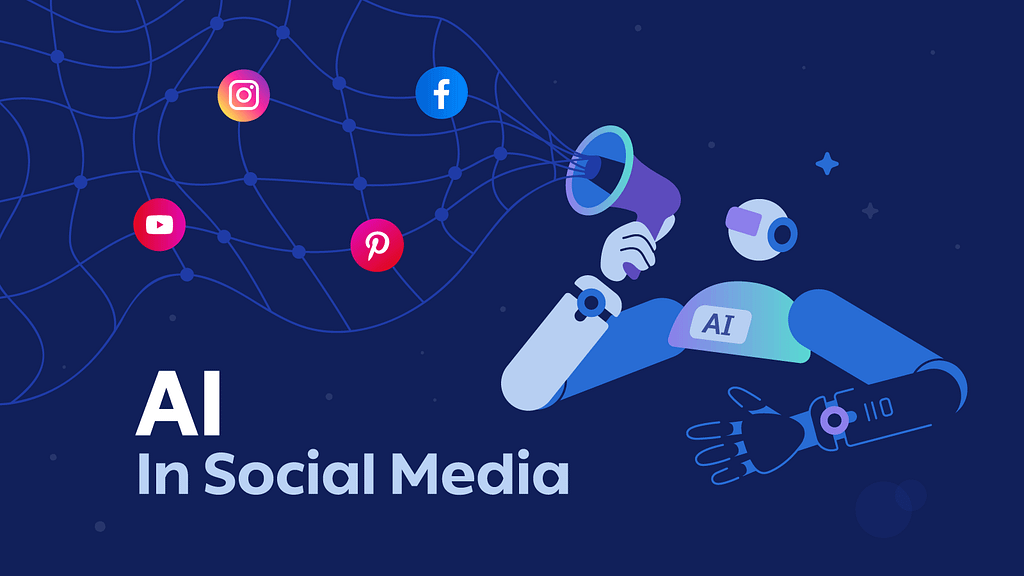
Furthermore, AI-powered tools will enable businesses to automate customer interactions, providing timely responses and fostering meaningful connections. Enhanced analytics will empower marketers to refine their strategies, making data-driven decisions that maximize impact. As social media evolves into a more dynamic and interactive space, the role of AI will be critical in shaping the way we communicate, connect, and consume content.
Embracing these innovations will be essential for brands and individuals alike, ensuring they remain relevant and competitive in this rapidly changing environment. The future of AI in social media is not just about connectivity; it’s about intelligent interaction.
Table of ContentWhat is AI in Social Media?
The Evolution of AI in Social Media
How AI Is Used In Social Media?
How AI Is Changing Social Media?
Key Predictions for 2025
How Do Social Media Companies Leverage AI?
Future Trends of AI In Social Media
ConclusionWhat is AI in Social Media?
AI in social media refers to the use of artificial intelligence technologies to enhance and optimize various aspects of social media platforms and user experiences. This integration allows for advanced data analysis, enabling platforms to understand user behavior, preferences, and trends more effectively. AI algorithms can analyze vast amounts of data in real-time, identifying patterns that inform content recommendations, targeted advertising, and personalized user experiences. For instance, machine learning models can predict which posts users are likely to engage with, thus curating feeds that align with individual interests.
Additionally, AI tools facilitate automated content generation, chatbots for customer service, and sentiment analysis, helping brands gauge public perception and respond accordingly. By leveraging natural language processing, AI can also enhance interactions through intelligent responses and improved content moderation, ensuring a safer and more enjoyable online environment. As AI continues to advance, its role in social media will expand, driving innovations that improve connectivity, engagement, and user satisfaction, ultimately transforming how we communicate and interact in the digital age.
The Evolution of AI in Social Media
The evolution of AI in social media has transformed how users interact with platforms and how brands connect with their audiences. Initially, social media utilized basic algorithms to curate content, but advancements in AI technologies have ushered in a new era of personalization and engagement. Early applications focused on user behavior analysis to deliver relevant ads and posts. As machine learning and natural language processing evolved, platforms began employing AI to enhance user experiences through intelligent chatbots, automated content generation, and sentiment analysis.
These tools allowed for real-time interactions and deeper insights into audience preferences. More recently, AI-driven innovations have led to the rise of predictive analytics, enabling brands to anticipate user needs and trends. Additionally, enhanced content moderation powered by AI helps create safer online environments by filtering out harmful content. As we move forward, the continued integration of AI in social media promises to redefine engagement strategies, enhance user satisfaction, and facilitate more meaningful connections between users and brands in an increasingly digital world.
How AI Is Used In Social Media?
AI is transforming social media in numerous ways, enhancing user experiences, optimizing content delivery, and streamlining operations for businesses. Here are some key applications of AI in social media:
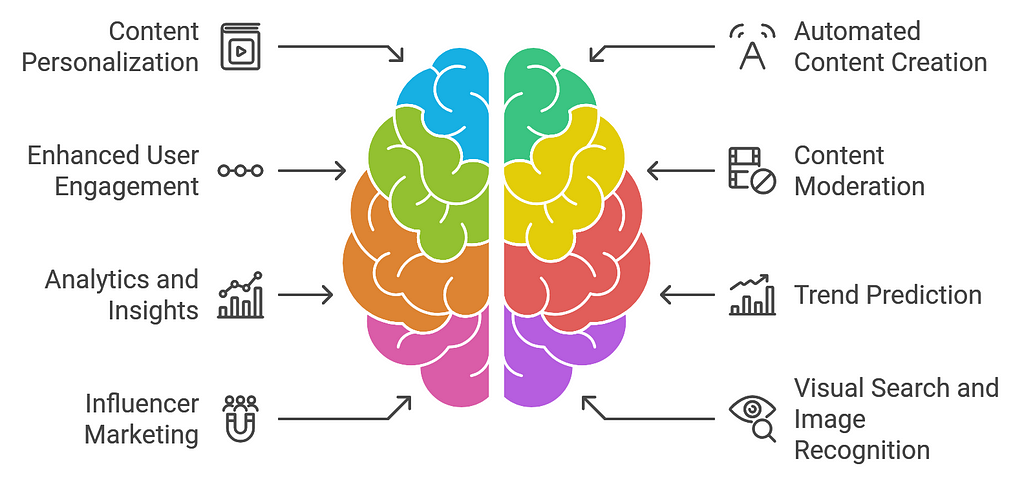 1. Content Personalization
1. Content Personalization
- Recommendation Algorithms: AI analyzes user behavior, preferences, and interactions to curate personalized feeds, ensuring that users see content that aligns with their interests.
- Targeted Advertising: AI-driven algorithms help businesses target specific demographics and user segments with personalized ads based on their browsing and engagement patterns.
2. Automated Content Creation
- Content Generation: AI tools can create text, images, and videos, enabling brands to produce high-quality content quickly and at scale. For example, AI can generate captions, articles, or even entire social media posts.
- Visual Content Creation: AI-powered design tools can assist users in creating engaging graphics, infographics, and videos, enhancing the overall visual appeal of social media content.
3. Enhanced User Engagement
- Chatbots and Virtual Assistants: Many social media platforms utilize AI-driven chatbots to provide instant responses to user inquiries, support customer service, and engage users in real-time.
- Sentiment Analysis: AI analyzes comments and interactions to gauge public sentiment about posts, brands, or campaigns, enabling businesses to respond appropriately and engage with their audience.
4. Content Moderation
- Automatic Moderation: AI algorithms are used to identify and filter out inappropriate content, including hate speech, spam, and misinformation, helping maintain a safe environment for users.
- Image and Video Recognition: AI can analyze visual content to detect sensitive images or videos that violate platform policies, assisting in content moderation efforts.
5. Analytics and Insights
- Social Listening: AI tools monitor social media channels to analyze trends, user opinions, and brand mentions, providing valuable insights for businesses to refine their strategies.
- Performance Metrics: AI analyzes engagement metrics, helping brands understand the effectiveness of their campaigns and content, allowing for data-driven decision-making.
6. Trend Prediction
- Predictive Analytics: AI models can forecast trends based on historical data and current user behavior, helping businesses stay ahead of emerging topics and tailor their content strategies accordingly.
7. Influencer Marketing
- Influencer Discovery: AI algorithms help brands identify suitable influencers based on audience demographics, engagement rates, and content relevance, streamlining influencer marketing efforts.
- Performance Measurement: AI analyzes the effectiveness of influencer campaigns, providing insights into ROI and engagement levels.
8. Visual Search and Image Recognition
- Visual Search: Users can search for products and content using images rather than text. AI analyzes the visual elements to find similar items or related content, enhancing the discoverability of products.
- Facial Recognition: Some platforms use AI for facial recognition to tag individuals in photos, facilitating easier connections and interactions among users.
9. Crisis Management
- Real-time Monitoring: AI tools can track and analyze conversations on social media to identify potential crises or negative sentiments before they escalate, allowing brands to respond proactively.
10. Enhancing Security
- Fraud Detection: AI algorithms are used to detect suspicious activity and fraudulent accounts, helping to protect users and maintain the integrity of social media platforms.
Through these applications, AI is revolutionizing social media, making interactions more personalized, efficient, and engaging while also helping brands and users navigate the complexities of the digital landscape. As AI technology continues to evolve, its impact on social media will only become more pronounced.
How AI Is Changing Social Media?
AI is fundamentally changing social media by reshaping how users interact with platforms, how content is created and consumed, and how businesses engage with their audiences. Here are several key ways in which AI is driving this transformation:
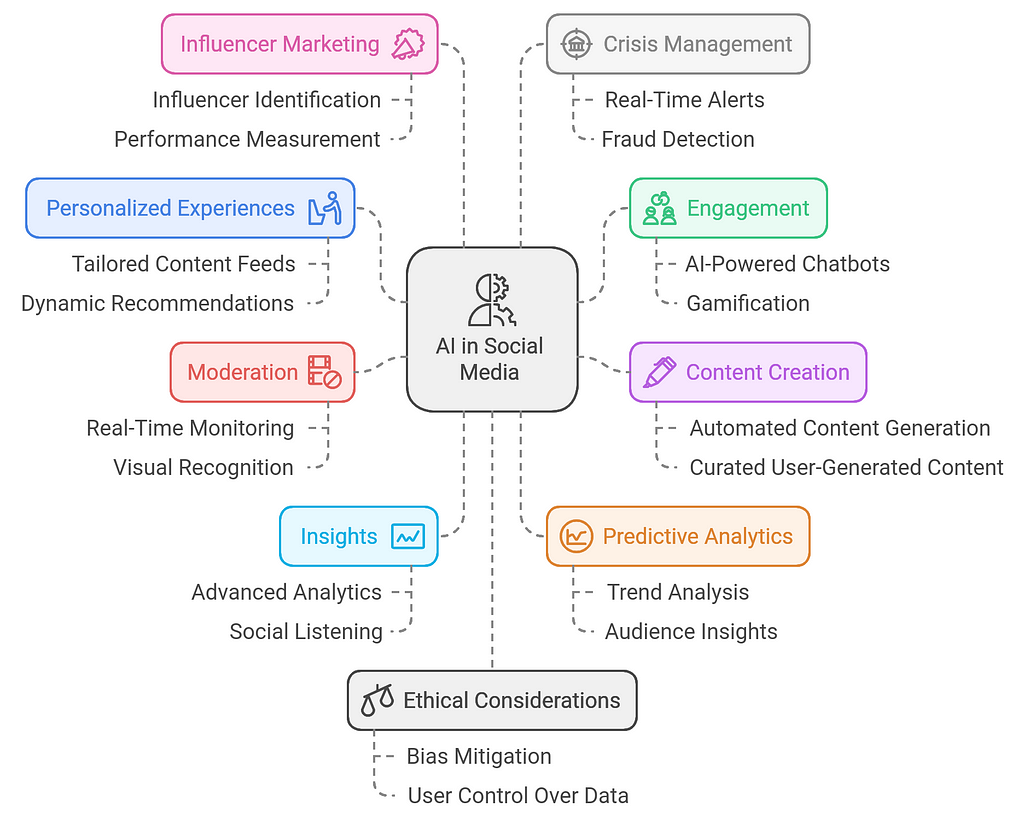 1. Personalized Experiences
1. Personalized Experiences
- Tailored Content Feeds: AI algorithms analyze user behavior, preferences, and interactions to deliver highly personalized content feeds. This ensures users see posts and ads that align with their interests, enhancing engagement.
- Dynamic Recommendations: Platforms like YouTube and Netflix use AI to recommend videos based on past viewing habits, making it easier for users to discover relevant content.
2. Enhanced Engagement and Interactivity
- AI-Powered Chatbots: Many social media platforms employ chatbots to provide instant responses to customer inquiries and facilitate user interactions, improving user satisfaction and engagement.
- Gamification and Interactive Content: AI enables the creation of interactive content, such as quizzes and polls, making social media more engaging and enjoyable for users.
3. Content Creation and Curation
- Automated Content Generation: AI tools can generate written content, graphics, and videos, allowing brands to produce high-quality posts efficiently. This includes creating captions, articles, and even entire social media campaigns.
- Curated User-Generated Content: AI can analyze user-generated content to curate and highlight the most relevant posts, fostering community engagement and showcasing user contributions.
4. Improved Content Moderation
- Real-Time Monitoring: AI systems are increasingly used for real-time content moderation, identifying and filtering out harmful content such as hate speech, misinformation, and spam before it reaches users.
- Visual Recognition: AI can analyze images and videos to detect inappropriate content, ensuring a safer online environment for users.
5. Data-Driven Insights
- Advanced Analytics: AI tools provide deeper insights into user behavior, engagement metrics, and campaign performance, enabling brands to make informed decisions and optimize their social media strategies.
- Social Listening: AI-driven sentiment analysis helps brands monitor conversations around their products and services, allowing them to gauge public opinion and respond appropriately.
6. Predictive Analytics and Trend Forecasting
- Trend Analysis: AI can identify emerging trends and predict user interests based on historical data, enabling brands to stay ahead of the curve and tailor their content accordingly.
- Audience Insights: By analyzing user demographics and behaviors, AI helps businesses understand their target audience better, leading to more effective marketing strategies.
7. Influencer Marketing Optimization
- Influencer Identification: AI tools help brands discover relevant influencers by analyzing their audience demographics, engagement rates, and content alignment, streamlining the influencer marketing process.
- Performance Measurement: AI provides metrics on influencer campaign effectiveness, helping brands assess ROI and make data-driven decisions about future partnerships.
8. Crisis Management and Brand Protection
- Real-Time Alerts: AI monitors social media conversations for potential crises or negative sentiment, allowing brands to respond quickly and mitigate issues before they escalate.
- Fraud Detection: AI algorithms help identify fraudulent accounts and suspicious activity, enhancing platform security and protecting users from scams.
9. Ethical Considerations and Transparency
- Bias Mitigation: As AI becomes more integral to social media, there is a growing emphasis on addressing biases in algorithms and ensuring transparency in how data is used and processed.
- User Control Over Data: AI advancements may lead to enhanced user control over personal data and privacy settings, allowing users to customize their online experiences.
10. Future of Commerce on Social Media
- Social Shopping Experiences: AI is enabling seamless shopping experiences within social media platforms, allowing users to discover and purchase products without leaving the app.
- Personalized Shopping Recommendations: AI analyzes user preferences and behavior to provide tailored product suggestions, enhancing the online shopping experience.
Overall, AI is fundamentally altering the social media landscape by making interactions more personalized, efficient, and secure. As technology continues to advance, the influence of AI on social media will likely deepen, creating new opportunities for users and businesses alike.
Key Predictions for 2025
As we look towards 2025, several key predictions can be made regarding the impact of AI on social media. These predictions highlight how AI technologies are expected to evolve and reshape the landscape of social media platforms:
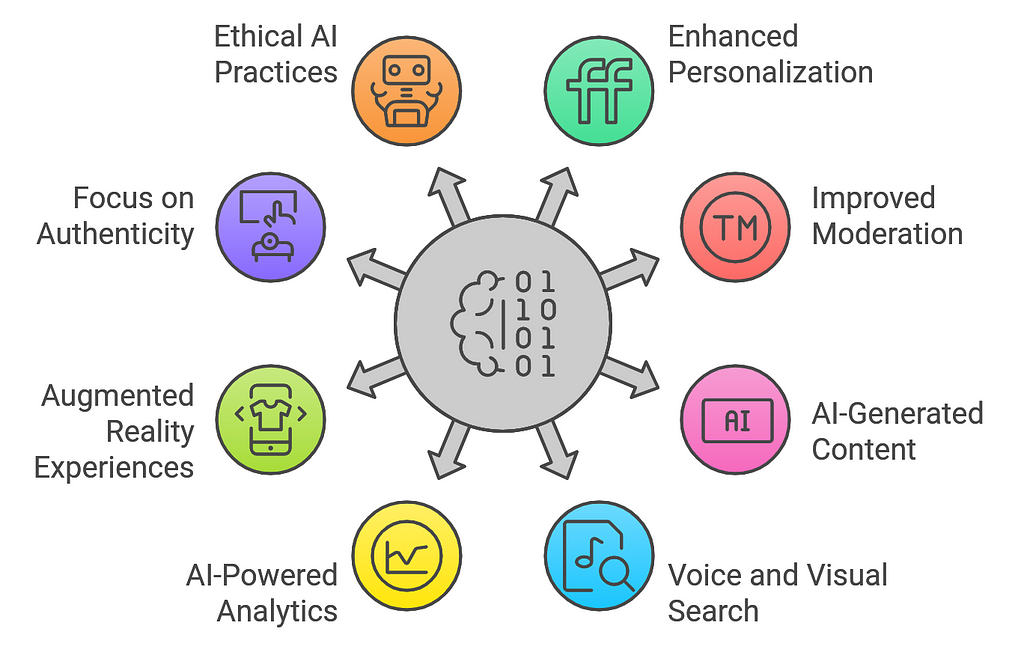
- Enhanced Content Personalization: AI algorithms will become increasingly sophisticated in curating personalized content for users. By analyzing user behavior, preferences, and engagement patterns, social media platforms will provide hyper-targeted feeds that enhance user satisfaction and engagement.
- Improved Moderation and Safety: AI will play a crucial role in content moderation, using advanced natural language processing (NLP) and machine learning techniques to detect hate speech, misinformation, and inappropriate content more effectively. This will help create safer online environments and reduce the spread of harmful content.
- AI-Generated Content: The use of AI tools for generating content, including text, images, and videos, will become commonplace. Brands and influencers will leverage AI to create engaging posts, stories, and ads, streamlining content creation processes and enhancing creativity.
- Voice and Visual Search: With the growing prevalence of voice-activated devices and visual search technology, social media platforms will integrate AI-driven voice and image recognition features, allowing users to search for content using voice commands or images, enhancing discoverability.
- AI-Powered Analytics: Marketers and brands will increasingly rely on AI for deeper insights into audience behavior and trends. Predictive analytics will help businesses anticipate user preferences, optimize marketing strategies, and measure campaign effectiveness in real-time.
- Augmented Reality (AR) Experiences: AI will enable more immersive AR experiences on social media platforms. Features like virtual try-ons and interactive filters will become more advanced, enhancing user engagement and driving commerce through social shopping experiences.
- Increased Focus on Authenticity: As AI-generated content becomes more prevalent, users will seek authenticity in their online interactions. Brands and influencers will need to strike a balance between leveraging AI tools and maintaining genuine connections with their audiences to foster trust.
- AI-Enhanced Customer Service: Chatbots and virtual assistants powered by AI will be integral to social media customer service, providing instant responses and support. This will lead to improved user satisfaction and more efficient handling of customer inquiries.
- Regulatory Challenges: As AI’s role in social media grows, regulatory scrutiny will increase. Governments will likely impose guidelines and regulations on data privacy, content moderation, and AI transparency to protect users and ensure ethical practices.
- New Monetization Models: AI will drive the development of innovative monetization models for social media platforms, such as dynamic ad placements and personalized subscription services. These models will enhance user experience while providing new revenue streams for platforms and creators.
- Ethical AI Practices: There will be a greater emphasis on ethical AI practices, including bias reduction, transparency in algorithms, and user consent. Social media companies will need to prioritize responsible AI use to maintain user trust and comply with emerging regulations.
- Collaboration Between AI and Humans: The future will see a collaborative approach where AI tools assist human creators rather than replace them. This synergy will enhance content quality and creativity while preserving the human touch that resonates with audiences.
By 2025, the integration of AI into social media will fundamentally transform how users interact with content, brands, and each other, shaping a more personalized, safe, and engaging online environment.
How Do Social Media Companies Leverage AI?
Top social media companies are increasingly leveraging AI technologies to enhance user experiences, optimize content delivery, and improve operational efficiencies. Here’s how some of the leading platforms are using AI:
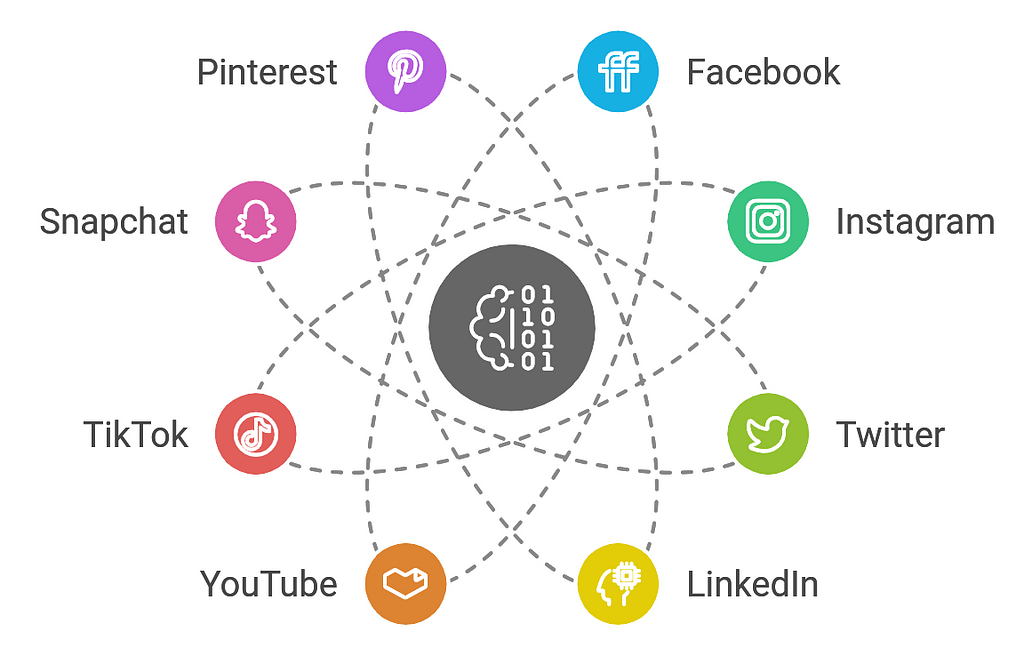 1. Facebook (Meta)
1. Facebook (Meta)
- Content Personalization: Facebook uses AI algorithms to curate user feeds by analyzing past interactions, preferences, and behaviors, ensuring users see the most relevant posts and ads.
- Image and Video Recognition: AI powers features like automatic tagging and content moderation, helping to identify and filter harmful or inappropriate content.
- Chatbots and Messenger: Facebook’s Messenger platform utilizes AI chatbots for customer service, enabling businesses to provide instant responses and support to users.
2. Instagram
- Smart Recommendations: Instagram employs AI to suggest accounts, hashtags, and posts based on user behavior, enhancing content discovery and engagement.
- Content Moderation: AI helps identify and restrict content that violates community guidelines, such as hate speech and bullying, ensuring a safer environment for users.
- Augmented Reality (AR) Filters: Instagram uses AI to create AR effects and filters that users can apply to their photos and videos, enhancing user interaction and creativity.
3. Twitter
- Real-Time Sentiment Analysis: Twitter employs AI to analyze tweets in real-time, helping to identify trending topics and gauge public sentiment during events or crises.
- Spam and Bot Detection: AI algorithms are used to identify and mitigate spam accounts and automated bots, improving the quality of user interactions.
- Content Curation: Twitter’s AI-driven algorithms curate trending topics and recommend tweets, enhancing the relevance of information presented to users.
4. LinkedIn
- Job Recommendations: LinkedIn uses AI to match job seekers with relevant opportunities based on their skills, experiences, and interactions, improving the job search process.
- Content Suggestions: AI analyzes user interests to provide personalized content recommendations, helping users discover relevant articles, posts, and insights.
- Skill Assessments: AI facilitates skill assessments and learning recommendations, allowing users to improve their profiles and increase their employability.
5. YouTube
- Video Recommendations: YouTube’s AI algorithms analyze user viewing habits to provide personalized video recommendations, increasing watch time and engagement.
- Content Moderation: AI is employed to detect and remove inappropriate content, ensuring compliance with community guidelines and enhancing user safety.
- Transcription and Captioning: AI technology generates automatic captions for videos, making content more accessible to a broader audience.
6. TikTok
- For You Page (FYP) Algorithm: TikTok uses AI to analyze user interactions and preferences to curate the For You Page, providing personalized content that encourages engagement.
- Video Effects and Filters: AI powers various video effects and filters, allowing users to enhance their content creatively and interactively.
- Trend Analysis: AI identifies emerging trends and challenges within the platform, enabling TikTok to promote relevant content and enhance community engagement.
7. Snapchat
- AR Experiences: Snapchat leverages AI to create engaging augmented reality experiences, allowing users to apply filters and effects to their snaps.
- Content Discovery: AI helps curate Stories and Discover content, tailoring recommendations based on user preferences and interactions.
- Snap Map: AI is used to analyze location data, allowing users to explore events and activities happening nearby through Snap Map.
8. Pinterest
- Visual Search Technology: Pinterest employs AI to enhance its visual search capabilities, enabling users to find related content and products through image uploads.
- Personalized Recommendations: AI algorithms analyze user activity to recommend Pins and boards that align with individual interests and preferences.
- Content Moderation: AI assists in moderating user-generated content to maintain community guidelines and improve the overall user experience.
9. Reddit
- Content Recommendation: Reddit uses AI to analyze user engagement and preferences, providing personalized subreddit and post recommendations.
- Spam Detection: AI algorithms help identify and remove spam content and accounts, enhancing the quality of discussions on the platform.
- Community Insights: AI analyzes community interactions to provide insights into trending topics and discussions, helping users stay informed.
10. Discord
- Moderation Bots: Discord utilizes AI-driven moderation bots to automatically filter out inappropriate content and manage community interactions.
- Voice and Video Quality Improvement: AI enhances voice and video quality during calls, providing users with a smoother communication experience.
- User Engagement Analysis: AI tools analyze user interactions to help server owners understand engagement levels and optimize community management.
These top social media companies are harnessing AI to enhance user experiences, improve safety, and streamline operations, ensuring that they remain competitive and responsive to user needs in an ever-evolving digital landscape. As AI technologies continue to advance, we can expect these platforms to further innovate and integrate AI in new and impactful ways.
Future Trends of AI In Social Media
As AI continues to evolve, its influence on social media will deepen, leading to several emerging trends that will shape the landscape in the coming years. Here are some key future trends of AI in social media:
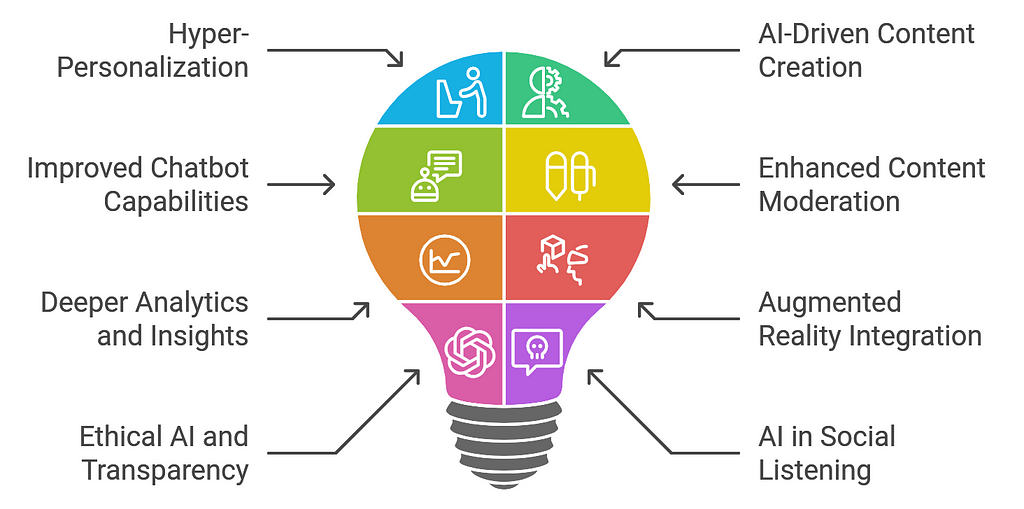 1. Hyper-Personalization
1. Hyper-Personalization
- Advanced Personalization Algorithms: AI will use even more sophisticated algorithms to provide highly tailored content, recommendations, and advertising, creating unique experiences for each user based on their real-time behaviors and preferences.
- Adaptive Content Feeds: Social media platforms will adapt content feeds dynamically, adjusting not only to user interactions but also to mood and context, as inferred by AI.
2. AI-Driven Content Creation
- Automated Video and Image Generation: AI tools will increasingly automate the creation of engaging videos, images, and graphics, allowing brands and individuals to generate high-quality content quickly and efficiently.
- Augmented Creativity: AI will serve as a creative partner for content creators, providing suggestions for topics, formats, and styles based on trending data and audience preferences.
3. Improved Chatbot Capabilities
- Conversational AI: Chatbots will become more advanced, utilizing natural language processing (NLP) to handle complex inquiries and provide more human-like interactions, improving customer service and user engagement.
- Contextual Awareness: Future chatbots will have greater contextual awareness, allowing them to maintain continuity in conversations and respond appropriately based on previous interactions.
4. Enhanced Content Moderation
- Proactive Content Filtering: AI will enhance content moderation by proactively identifying and filtering harmful content before it reaches users, reducing the burden on human moderators and improving user safety.
- Visual Recognition Improvements: Continued advancements in image and video recognition will help platforms identify and manage inappropriate visual content more effectively.
5. Deeper Analytics and Insights
- Predictive Analytics: AI will provide predictive analytics capabilities that help brands anticipate trends and user needs, allowing them to tailor their marketing strategies proactively.
- Emotion Analysis: AI tools will analyze user sentiment and emotional responses to content, giving brands deeper insights into audience reactions and preferences.
6. Augmented Reality (AR) Integration
- AR Experiences: AI will power more sophisticated AR features on social media platforms, enabling users to interact with virtual objects and experiences seamlessly integrated into their real-world environments.
- Interactive Shopping: Enhanced AR tools will allow users to visualize products in their own spaces before making purchases, revolutionizing online shopping experiences.
7. Ethical AI and Transparency
- Bias Mitigation Efforts: As concerns about AI bias grow, social media platforms will prioritize developing algorithms that reduce bias and promote fairness in user interactions and content delivery.
- Transparency in Data Usage: Brands will provide clearer insights into how user data is collected and utilized, fostering trust and confidence among users.
8. AI in Social Listening
- Real-Time Sentiment Tracking: AI will enhance social listening tools, enabling brands to monitor public sentiment in real-time and respond to changes in public opinion swiftly.
- Trend Identification: AI will assist brands in identifying emerging trends and cultural shifts on social media, allowing them to adapt their strategies accordingly.
9. Social Commerce Evolution
- Integrated Shopping Experiences: Social media platforms will further integrate e-commerce capabilities, allowing users to discover, browse, and purchase products directly through their feeds, facilitated by AI recommendations.
- Personalized Shopping Assistants: AI will act as a personal shopping assistant, guiding users through their buying journey based on past purchases and preferences.
10. Greater Focus on Mental Health
- User Well-Being Features: AI will help identify harmful content or behaviors related to mental health, enabling platforms to implement features that promote user well-being and positive interactions.
- Supportive Communities: AI can facilitate the formation of supportive online communities that foster positive engagement and mental health resources.
11. Enhanced User-Generated Content
- Quality Control: AI will assist in curating and promoting high-quality user-generated content, helping brands discover authentic voices that resonate with their audience.
- Engagement Metrics: AI tools will analyze user-generated content for engagement metrics, allowing brands to recognize and reward community contributions effectively.
12. AI-Driven Influencer Marketing
- Influencer Performance Analysis: AI will provide deeper insights into influencer effectiveness, helping brands make data-driven decisions about partnerships and campaign strategies.
- Automated Campaign Management: AI will streamline influencer marketing campaigns, automating tasks such as outreach, contract management, and performance tracking.
The future of AI in social media promises to create more personalized, engaging, and safe environments for users while providing brands with advanced tools to connect with their audiences effectively. As these trends unfold, social media will continue to evolve into a more interactive and dynamic space shaped by AI technologies.
Conclusion
In conclusion, the future of social media in 2025 will be significantly influenced by the transformative power of artificial intelligence. As AI technologies continue to evolve, they will not only enhance user experiences but also revolutionize how brands interact with their audiences. By harnessing the capabilities of AI, social media platforms will facilitate more personalized, engaging, and meaningful connections, allowing users to discover content that truly aligns with their interests. Businesses that embrace these advancements will gain a competitive edge, utilizing data-driven insights to craft targeted strategies and optimize their messaging.
Moreover, the automation of customer interactions will lead to increased efficiency, enabling companies to respond swiftly to inquiries and build lasting relationships with their audiences. As we navigate this new landscape, brands and individuals must adapt and innovate, ensuring they leverage AI’s potential to foster deeper connections and enhance their online presence. The integration of AI into social media is not just a trend; it represents a fundamental shift in how we communicate and connect in a digital world, paving the way for a more interactive and intelligent social experience.

AI in Social Media: The Next Big Thing in 2025 was originally published in Coinmonks on Medium, where people are continuing the conversation by highlighting and responding to this story.




 Southeast Asia’s economy has rapidly expanded over recent years — and there’s no sign of slowing down. In fact, the GDP growth of Southeast Asia is projected to outpace …
Southeast Asia’s economy has rapidly expanded over recent years — and there’s no sign of slowing down. In fact, the GDP growth of Southeast Asia is projected to outpace …



 1. Content Personalization
1. Content Personalization 1. Personalized Experiences
1. Personalized Experiences
 1. Facebook (Meta)
1. Facebook (Meta) 1. Hyper-Personalization
1. Hyper-Personalization